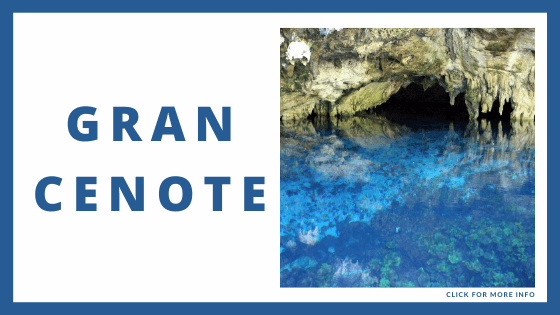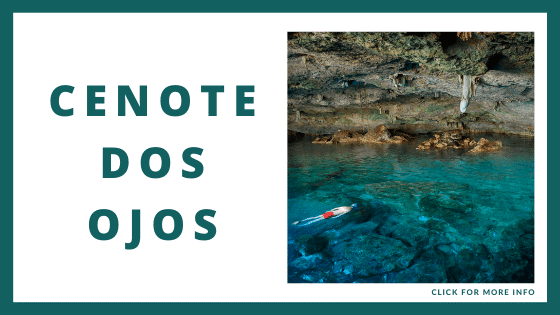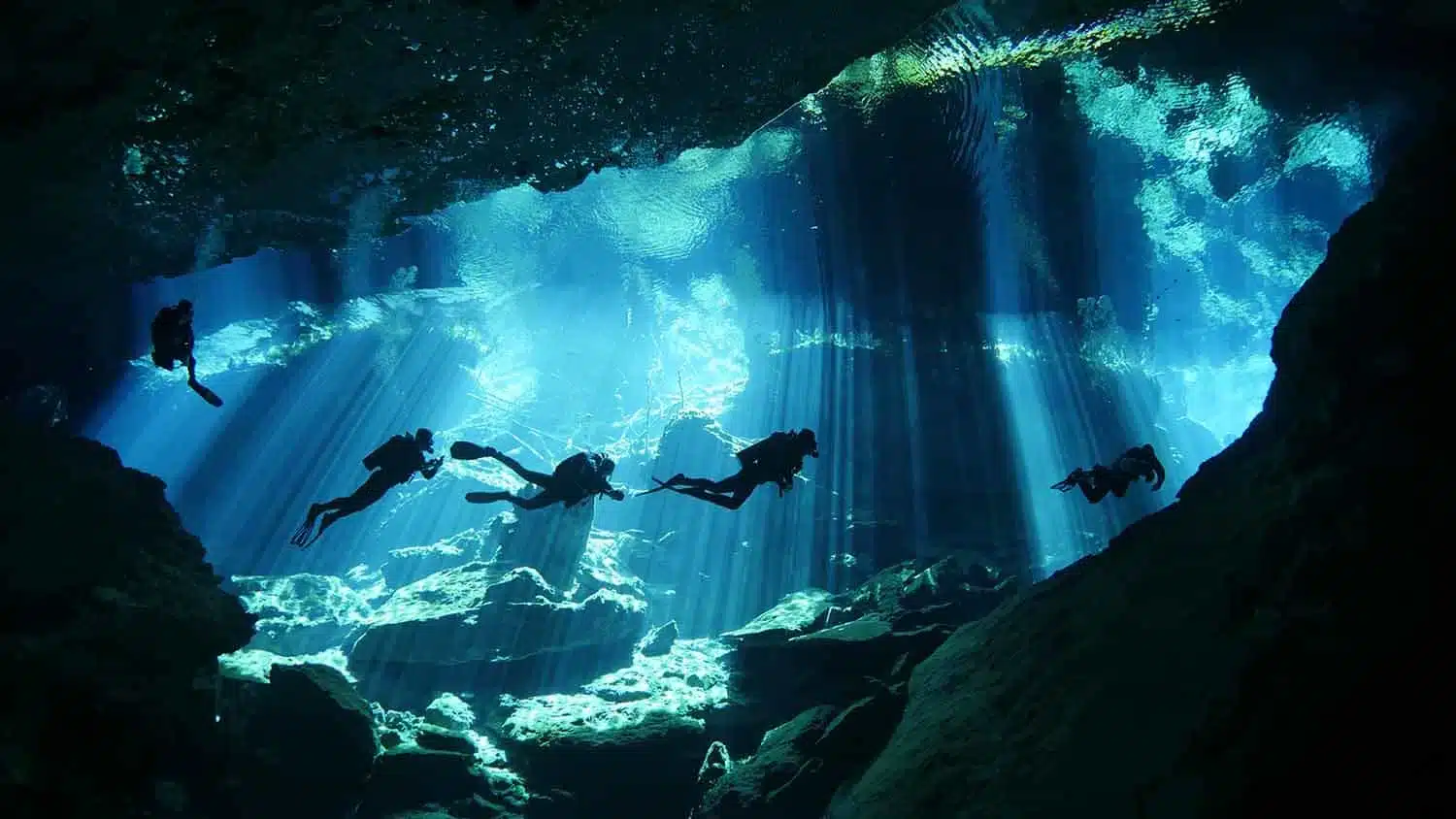There is something spectacular about diving in the ocean, but diving in a cenote takes it all to a new level. The other-worldliness of it and the stark beauty of what’s beneath the surface is indescribable. If you are a big fan of diving in oceans, then you absolutely need to try cenote diving.
There are incredible amounts of cenotes in and around Tulum (literally thousands). However, these are our top three:
- Gran Cenote
- Cenote Dos Ojos
- Cenote Ak Tun Han, aka the Cenote Car wash
There is nothing like diving into a subterranean world. And to do so, there is no better place than Tulum, located on the Yucatán Peninsula of Mexico. If you are considering traveling to Tulum to experience the one-of-a-kind feeling of diving into a cenote, or are just curious about what a cenote even is, then keep reading.
What is Cenote Diving?
Cenote diving is the process of swimming, snorkeling, or scuba diving in a freshwater sinkhole. Cenotes form when the roof of a cavern collapses and is filled in by rainfall and an underground river.
Cenotes most notably form in limestone rock due to limestone’s softer and less durable geological properties. Overtime, cenotes have been known to form in three distinct ways:
- Open cenotes: these cenotes are akin to a small lake, pond, or pool. They form when an underground cave collapses and is filled with water. Open cenotes are great for those who just want to float, swim and snorkel.
- Semi-open cenotes: these cenotes are considered underground but have some sort of opening in the roof that allows fresh air, rainfall, and natural light to enter. It’s like swimming in an indoor pool without a roof. Semi-open cenotes are ideal for those who want to swim and snorkel but still have a quasi-underground experience.
- Underground cenotes: these cenotes are completely underground and cut off from natural light. Underground cenotes are a complex of caves, caverns, and tunnels that are filled with water from underground reservoirs. These cenotes are excellent for divers wanting to explore a dark and mysterious underground world.
Cenote diving has become a popular tourist attraction in many parts of Mexico, especially along the Yucatán Peninsula. On the peninsula alone, there are over 6,000 cenotes. However, the usage of cenotes is an ancient practice with important cultural significance.
The word cenote comes from the Mayan word dzonot, which roughly translates to “well.” The Maya used cenotes as valuable water sources and considered cenotes to be sacred. Specifically, the Maya believed cenotes to be passageways to and from the underworld.
For that reason, respecting the heritage of cenotes is of utmost importance. You’re not just enjoying the pool at a luxury hotel. You are stepping into, if not diving into, an experience embedded with intense cultural and geological history.
Cenote swimming, snorkeling, and diving have become an integral part of the local tourist economy all across the Yucatán Peninsula. Tulum, in particular, is an excellent jumping-off point (pun intended) for experiencing the wonders of cenotes.
If you are staying in Tulum or visiting from another location, then it is highly recommended you spend a day enjoying at least one of the many cenotes the area has to offer.
The Top 3 Cenotes to Dive in Tulum Mexico
The sheer number of cenotes in and around Tulum is impressively large. There are too many to visit in a lifetime. So trying to visit them all on a single trip is just impossible.
That’s why focusing on the best of the best is the preferred strategy. We’ve done some research and conjured up a top 3 list of cenotes in Tulum. If you are able to visit even just one of these amazing cenotes, your experience in Mexico will be transformed.
The Gran Cenote
The Gran Cenote is the crown jewel of cenotes in Tulum. Its name translates to “the great cenote.” It is composed of a network of caves, caverns, and open-air watering holes. All surrounded by wooden boardwalks and tropical green gardens.
To be specific, the Gran Cenote contains roughly 140 square meters (~420 feet) of water for swimming, snorkeling, and diving. That’s a lot!
The Gran Cenote, and its crystal clear waters, is great for swimming, snorkeling, and scuba diving. The water remains at a comfortable temperature all year round but feels the best and most refreshing during the hotter parts of the year.
If you are lucky, you may even spot some wildlife, like turtles.
The Gran Cenote is very popular and therefore can become a little busy. It is recommended to try and avoid the midday crowds. Try to visit early in the morning after opening or later in the afternoon before closing time.

Cenote Dos Ojos
The English translation of Dos Ojos is “two eyes.” Cenote Dos Ojos is named after the two individual cenotes in the same area, connected by a 400-meter long (~1,300 feet) underwater passageway. Each has its own special vibe, and both should be visited if you are in the area.
Cenote Dos Ojos is a beautiful, semi-open cenote with crystal clear waters. The water remains warm and refreshing and takes on a beautiful blue hue thanks to the natural light entering through the roof.
There is some wildlife at this cenote as well. It is common to observe bats living amongst the stalactites on the roof. Although maybe a little spooky, the presence of the bats and the cave-like setting make for a really special experience.

Cenote Ak Tun Ha
Another well-known cenote around Tulum is the Ak Tun Ha, also known as Cenote Carwash. Why, you might ask? Well, in the past, this body of water was used for washing cars.
Cenote Carwash is located near the road and is very easily accessible. To a large degree, it is an open-air cenote. But it also contains some underwater caverns and tunnels, upwards of 50-meter (165-feet) deep. For that reason, the Cenote Carwash is a popular destination for divers. But this cenote is also great for swimmers and snorkelers.
Cenote Carwash is surrounded by lush green vegetation and gives a tropical jungle feel, despite being located near the road.
Although highly accessible, Cenote Carwash remains slightly less busy than some other, larger cenotes. The less busy atmosphere is great for soaking in the quietness and relaxing.
Wildlife like fish, turtles, and maybe even crocodiles can be spotted at Cenote Carwash. It should be noted that if you are lucky enough to observe wildlife, absolutely leave them alone and only enjoy them from a distance.

What's the Difference Between Cenote and Ocean Diving?
Cenote diving is a unique experience. If you are accustomed to diving in the ocean, then you’re off to a good start when it comes to cenote diving. However, there are some important differences between cenote and ocean diving.
- Type of water: cenotes are comprised of freshwater instead of saltwater. The water in cenotes comes from rainfall and water reservoirs located underground.
- Temperature: cenotes tend to be much warmer than ocean water. This makes the diving experience a bit more accessible without wetsuits. Many cenotes hover around 70 degrees Fahrenheit.
- Depth: cenotes are normally not as deep as certain parts of the ocean. With that said, there are still some impressively deep cenotes and long passageways.
- Wildlife: due to the freshwater environment, the wildlife will be very different in cenotes than in oceans. Freshwater fish and turtles are commonly observed in cenotes, along with the occasional crocodile. Don’t forget about the bats!
- Ecosystem: instead of diving to coral reefs and underwater kelp forests, cenote diving consists of exploring underwater caverns and tunnels. Therefore, the ecosystem is vastly different from the ocean. You might not see as much wildlife, but the geological formations you observe, like stalactites and stalagmites, are incredibly unique to cenotes.
- Water clarity: Cenotes are famous for their crystal clear waters. Oceans, on the other hand, can sometimes be less clear. This is especially true when the waters are turbulent, and the currents are strong.
If you’ve got a fear for sharks or are otherwise uncomfortable is the vastness of the ocean but still love exploring underwater worlds, then cenote diving is the perfect experience for you.
(Looking for another cheap tropical island to vacation to? Check out that article for the best of them!)
How Can I Find a Guide for Cenote Diving in Tulum Mexico?
No trip to Tulum is complete without visiting a couple of cenotes. However, the number of cenotes, and the logistics involved, can be overwhelming. That is why it might be best to hire a guide.
A good guide will have expert opinions based on a lot of cenote experience. They will understand which cenote is best for your trip, and other important points like:
- Transportation: renting your own car abroad can be a headache. Sometimes, having a professional driver is much easier and safer.
- Translation: guides are great for communicating with locals if your Spanish is lacking. Nothing will get lost in translation, and you may even have a more authentic experience!
- Strategic times to visit: guides have years of experience, and therefore, will know the best times to visit certain cenotes. This will help guarantee that your visit is not overly crowded.
- What to bring: do you ever find yourself thinking, “I wish I brought that.” Well, most guide services prepare you with a list of the necessities to bring to ensure your experience is excellent. And if you still forget something, there’s a chance your guide will have a back-up.
Finding a guide has never been easier. There are all kinds of guided packages available on GetYourGuide. On their website, you will be able to find various day trips and sightseeing tours that will bring you to different cenotes. TripAdvisor also has a pretty impressive lineup of cenote tours available.
Whatever your budget and objective might be, there will absolutely be a guided experience that meets, if not exceeds, your expectations!
Also, you’ll want to be sure you are staying in the right place. Check out this article on Tulum Airbnb or hotel to compare which one you should stay at!
Conclusion
Cenotes are incredible geological phenomena with important historical and cultural value. Nowadays, they offer a booming tourist industry that supports locals economies and connects travelers with amazing experiences.
Whether you are interested in swimming, floating and relaxing, or diving deep into an underwater adventure, there is a cenote that fits the bill. Plus, there are many other great things to do in Tulum!
Tulum, and the greater Yucatán peninsula, is an incredible place to visit. The thousands of cenotes waiting for your arrival are an absolute “must-do” experience that will transform your visit into an unforgettable one.
(While you are researching your trip, you will definitely want to check out these Tulum Airbnb experience!)


